How to cut an onion - it seems like such a simple task, right? But maybe not. In this post, we'll learn all about the different types of onions, why onions make you cry, the best way to cut an onion for both sliced onion and diced onion, and how to store cut onions for later use.
In the beginning, I only planned to talk about the easiest way to cut an onion. I learned it in a cooking class years ago and I've been using it ever since, and I thought it would be helpful to share with others.
But then I started digging around, and discovered how many layers onions truly have! There's even a National Onion Association - who knew? So before we talk about how to cut an onion, let's dig in.
Onions: A brief history
From what I found, it seems like it is believed by many archaeologists, botanists, and food historians that onions originated in central Asia. Other research suggests onions were first grown in Iran and West Pakistan.
Wild onions have been consumed long before farming, and are thought to have been a part of a regular diet in prehistoric times. Since onions grew wild in various regions, they were probably consumed for thousands of years and domesticated simultaneously all over the world.
Onions are thought to be one of the earliest crops because they were less perishable, were transportable, easy to grow, and would grow in many different types of soil and climates.
Onion was also useful for sustaining human life. Onions could prevent thirst and could be dried and preserved for later consumption when food might be scarce.
Different types of onions
Yellow onion
Yellow onions are the most popular variety, as they are more of an "all purpose onion." A whopping 87% of onions grown in the U.S. fall under the yellow onion category!
Sweet yellow onions are the most commonly known variety (my favorite are Vidalias!)
Easily sauteéd or grilled, cooking yellow onions brings out their nutty, sweet, and mellow flavor.
Red onion
About 8% of the U.S. onion crop is comprised of red onions. They have less water content than the yellow variety and can be more pungent.
Cooking them lightly can take the 'bite' out of them and reduce the sharpness of their flavor when served raw.
My favorite use for red onions is to make pickled red onions and then use them on top of salads, burgers, eggs, and more!
White onion
White onions make up only 5% of the U.S. onion crop each year. These onions are most commonly used in Mexican or Southwestern cuisine, and are often seen in potato salad and pasta salad.
I love to use them in my Pico de Gallo recipe.
White onions are slightly more compact in their structure, so they don't keep quite as long as the other varieties.
Want to learn more about the different onion varieties? Check out this post.
Storage and Handling
Basic storage & handling tips for dry bulb onions
Onions can last quite awhile if stored properly! Here are a few tips on how to get the most out of your onion life:
- Onions should be stored in a cool, dry, area. Ideal temperature is between 45-55°F. (That's tough, because it's in between fridge and room temperature! Think like a cool cellar, if you're going for very long term storage.)
- Allowing airflow around the onions will increase shelf life. Stacking them and crowding them will reduce it.
- Onions should feel firm and dry. They should not be kept in sunlight.
- Keep them clear of produce such as potatoes or other produce items that release moisture.
Why onions make you cry
We don’t cry when we should, and we cry for no reason. But let’s take a moment to appreciate the clarity of crying while cutting onions.
Onions make us teary because a reaction in the onion releases a chemical called lachrymatory factor, or LF, that irritates our eyes.
Simply peeling an onion won’t make your eyes water. But if you chop, cut, crush or smash one — boohoo. The onion’s cells break open, allowing two normally separated substances to combine. Linked together like pieces of a puzzle, they become a potent chemical weapon.
The trick to avoiding tears is to keep your exposure to the cut sides of the onion to a minimum. When an onion is cut, fumes are released that irritate the eyes.
So when you cut an onion in half, keep the cut sides down on the cutting board. When you first start to make cuts into the onion, keep the onion together so you don't expose the cuts.
A couple of other tricks are to chuck your onion in the fridge before you cut it, or submerge it in water while chopping. This dilutes the gas, but also reduces the flavor, so it's a give and take.
I can never remember to put my onion in the fridge the few minutes before cutting, so once I peel it and cut it in half, I rinse it under cold water, and that seems to help a bit.
But sometimes, for the love of onions, you just have to cry.
How onions grow
Generally speaking, onions grow tops in cool weather and form bulbs when the weather warms. You can find a full growing guide for onions here.
The parts of an onion
Tunic : The dried up layer on the outside, which we don't eat. This acts as a protective barrier for storage and preservation.
Scales: These are the layers of the onion. Outer scales are usually membranous and inner scales are fleshy.
Bud: Just like the name suggests, this is the "flower" bud of the onion, or where it sprouts from when it begins to grow.
Basal Plate: The plate at the bottom of the onion of which the roots and bud grow from.
Roots: The roots of the onion which grow into the ground to supply it with nutrients and water through it's life cycle. They're often trimmed short but still intact on onions you purchase.
Non-food uses for an onion
In addition to being delicious, onions have many other magical uses! Here are just a few:
Keep cut avocados from going brown - A cut onion stored with the cut avocado will help preserve the avocados green color longer.
Absorb odors - Got a smell you can't get rid of? Fresh paint, or soemthing else? Place a cut onion in a dish in the room and give it a few hours, the onion will absorb the smell.
Curative powers — Onion’s pungent juices will help soothe a bee sting. Fresh cut onion juice will also help soothe a burn to the skin!
As a grill-cleaner - Ditch the harsh chemicals and clean your grill off with an onion. Then put the onion in the coals to provide a mellow onion flavor to your meats.
Windshield de-icer - In winter months, rub a cut onion on your windshield at night to make removing ice in the morning a breeze. The juice creates a barrier that makes the ice scrape off easily!
Rust remover - Rub a onion on knives with rust spots to remove the rust.
Fun Onion Trivia
How many pounds of fresh and storage type onions does the average American eat per year?
20 pounds.
How many truckloads of onions are consumed each day?
Over 450 semi-truck loads.
What country boasts the highest per capita consumption of onions?
Libya, with 66.8 pounds of onions consumed per person each year.
A single serving of onion contains how many calories?
45 calories.
According to the Guinness Book of World Records, how much did the largest onion ever grown weigh?
18 pounds, 11.84 ounces pounds. It was grown by Tony Glover, United Kingdom and was set on Sept. 12, 2014.
What should you eat to get rid of onion breath?
Parsley.
How to cut an onion
The best way to cut an onion
The best way to cut an onion is by keeping the root ball intact as long as possible. This is where the majority of the gases and juices that cause your eyes to water are, so the longer we wait to cut that part, the less of that we’re releasing into the air.
You’ll cut the onion in half first, give it a quick rinse for any released juices, and then cut towards the root ball in angled slices.
From there, you can leave it sliced, if you’re looking for long pieces to make something like Sheet Pan Chicken Fajitas or Copycat Chipotle Burrito Bowls.
Or, you can turn and dice into small pieces, for recipes like Pico de Gallo, Damned Delicious Guacamole, or Sausage and Onion Egg Casserole.
How to cut an onion: step-by-step, with pictures!
- Peel all the loose paper off the onion and discard. Some will come off easily, some may need a bit of encouragement. You’re looking to get down to the first solid layer that you can’t just rub at with your hands to shed.
2. Using a sharp knife and cutting board, lay the onion on it’s side and cut off the “not root end” and discard.
3. Cut the onions in half lengthwise. You’ll be making a single cut through the root ball end, to create two halves with one flat side each. Each side will have a root ball attached, as well as a clean end that you just trimmed off.
4. Rinse the onion. Sometimes with that initial cut, some liquid will be released. Give both sides a rinse in cold water.
5. Lay the onion on the cutting board cut side down. Start with the root ball end closest to you.
6. Slice the onion. Using your (very) sharp knife, make equidistant cuts at an angle from the outer layer towards the center, leaving the root ball intact. This is important - don’t cut all the way through!
I’m left handed, so I work left to right; if you’re right handed you’ll work the other way, from right to left. Once you get to the top of the onion (halfway), turn it 180° and continue to make the same cuts on the other side.
Note: If you’re looking for how to dice an onion, skip steps 7 + 8 and jump to step 9!
7. Cut off the root ball. Hold the sliced onion still with one hand. Using the knife, make a single cut perpendicular to the previous cuts to remove the root ball.
8. Break up the slices. Use your hands to separate the onion slices before using in your recipe.
9. Looking for a dice? If you want to dice your onion, turn it 90° on the cutting board and make cuts across the ones you just made. Continue to make these cuts, working your way towards the root ball. When you can no longer make a cut, flip it so the root ball is on top, and cut on all sides until only a small square with the root ball remains. Discard the root ball.
Pro tip: Hold the onion firmly with your fingers curled so that your knuckles press against the side of the knife as you cut the onion (this protects your fingertips from getting cut).
How to store cut onions
- Once peeled and/or cut, onions needs to be refrigerated.
- Tightly wrapped onions with plastic wrap or in a silicone bag can be refrigerated for up to seven to 10 days.
How to freeze cut onion
Once I figured out how to freeze fresh produce, I couldn’t believe how easy it was!
What you don’t want is all the pieces to stick together. If we take all of our cut onion, throw it in a bag, and put it in the freezer, they’re all going to freeze together in a big onion brick.
Instead, get a baking sheet, and spread them out in a single layer on it. Place the baking sheet in the freezer, which will allow the pieces to freeze individually.
Once they’re frozen, use a sturdy spatula to scrape them from the pan. Put them in a bag or Tupperware of your choice that can be sealed, and store in the freezer for later use.
They will be frozen separately, so you can reach in, grab a handful, and not have to defrost the whole bag at once. Magical.
You can use this technique for almost anything - berries, potatoes, broccoli florets, peppers - just slice or cut like you’re going to use, then freeze on a baking sheet and put in bags.
One of our favorite kitchen tools is the FoodSaver - once we cut and freeze, we separate into small packs and vacuum seal to keep air out and eliminate freezer burn. If you don’t have a FoodSaver, you can simply use a Ziplock bag and press out as much air as you can before putting in the freezer.
Recipes for using your cut onion
Onions are one of my favorite vegetables - they’re versatile, easy to work with, and pack a mean punch when combined with garlic. I use onion in lots and lots of my recipes, but here are just a few ideas:
Sausage and Onion Egg Casserole
Copycat Chipotle Burrito Bowls
Now, here's how to cut an onion the easiest way with the least amount of tears!
Recipe

How to Cut an Onion
How to cut an onion - an everyday kitchen task, made simple with a few easy steps. Minimize tears and get the most out of your onion with this kitchen tutorial.
Materials
- onion
Tools
- sharp kitchen knife
- cutting board
Instructions
- Peel all the loose paper off the onion and discard. Some will come off easily, some may need a bit of encouragement. You’re looking to get down to the first solid layer that you can’t just rub at with your hands to shed.
- Using a sharp knife and cutting board, lay the onion on it’s side and cut off the “not root end” and discard.
- Cut the onions in half lengthwise. You’ll be making a single cut through the root ball end, to create two halves with one flat side each. Each side will have a root ball attached, as well as a clean end that you just trimmed off.
- Rinse the onion. Sometimes with that initial cut, some liquid will be released. Give both sides a rinse in cold water.
- Lay the onion on the cutting board cut side down. Start with the root ball end closest to you.
- Slice the onion. Using your (very) sharp knife, make equidistant cuts at an angle from the outer layer towards the center, leaving the root ball intact. This is important – don’t cut all the way through! I’m left handed, so I work left to right; if you’re right handed you’ll work the other way, from right to left. Once you get to the top of the onion (halfway), turn it 180° and continue to make the same cuts on the other side.
- Cut off the root ball. Hold the sliced onion still with one hand. Using the knife, make a single cut perpendicular to the previous cuts to remove the root ball.
- Break up the slices. Use your hands to separate the onion slices before using in your recipe.
- Looking for a dice? If you want to dice your onion, turn it 90° on the cutting board and make cuts across the ones you just made. Continue to make these cuts, working your way towards the root ball. When you can no longer make a cut, flip it so the root ball is on top, and cut on all sides until only a small square with the root ball remains. Discard the root ball.
Notes
Pro tip: Hold the onion firmly with your fingers curled so that your knuckles press against the side of the knife as you cut the onion (this protects your fingertips from getting cut).
If you want diced onion and not sliced onion, skip straight to step 9 from step 6, eliminating steps 7 and 8!
I crawled into the vegetable bin, settled on a giant onion and ate it, skin and all. It must have marked me for life for I have never ceased to love the hearty flavor of onions.”
-James Beard, American cooking expert and author
I may earn a small commission off purchases made through affiliate links in this post from Amazon and other sellers. This helps me continue to run the blog and keep providing you fresh content. Thank you for your support!

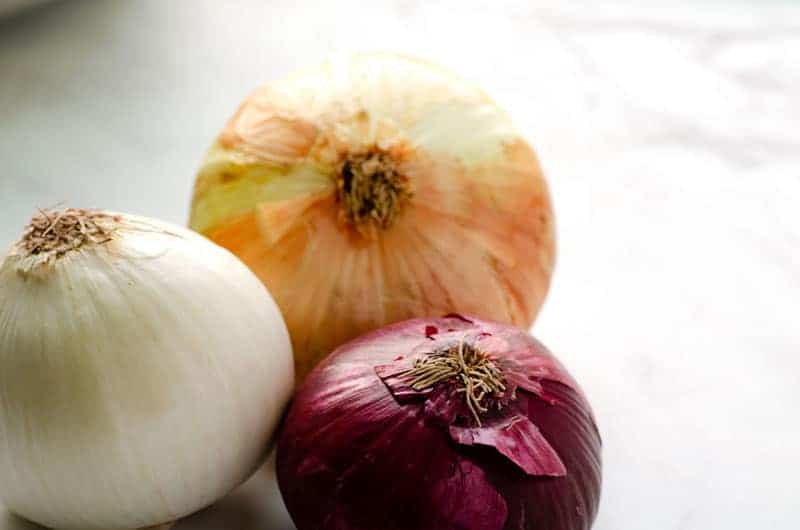
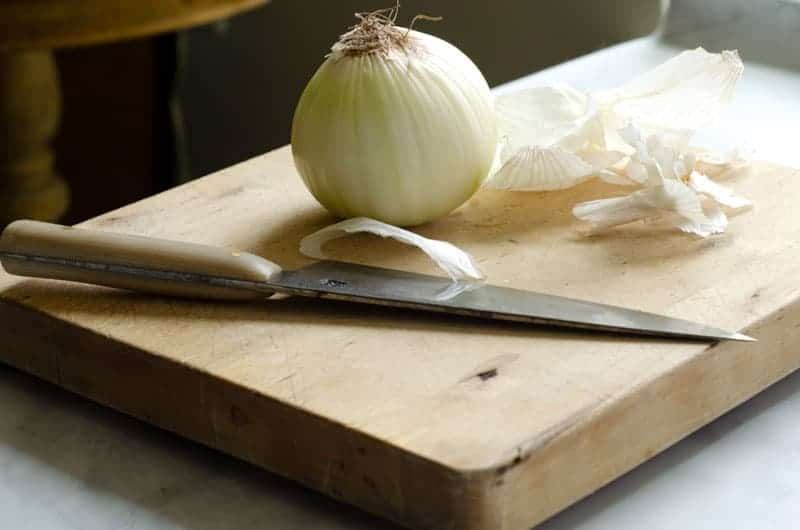


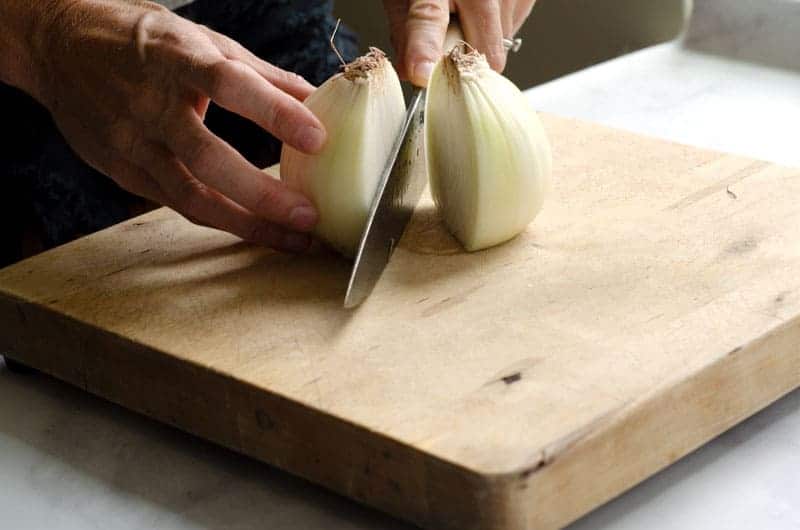






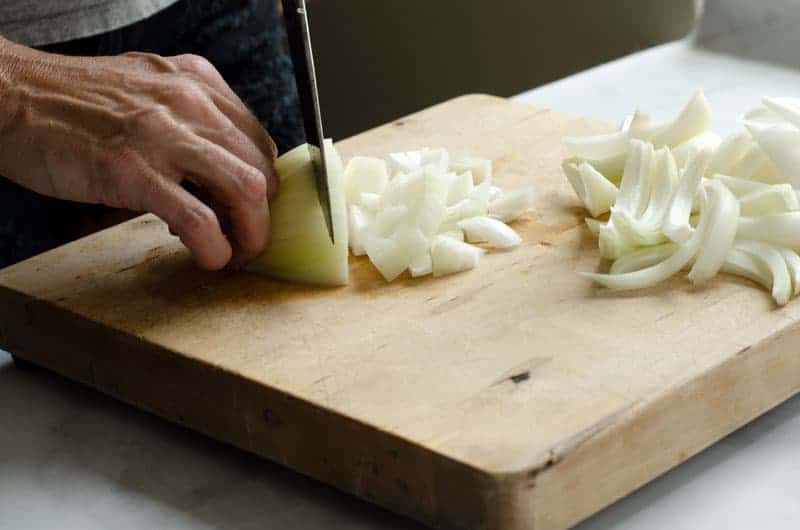



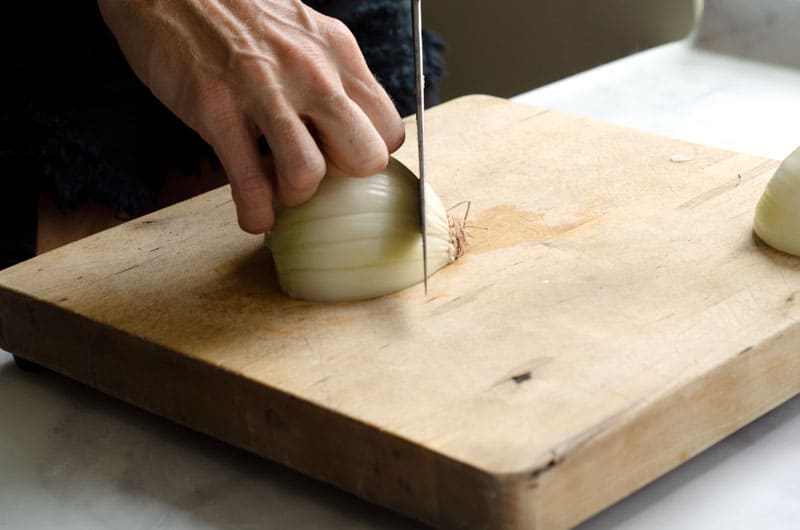




Leave a Reply